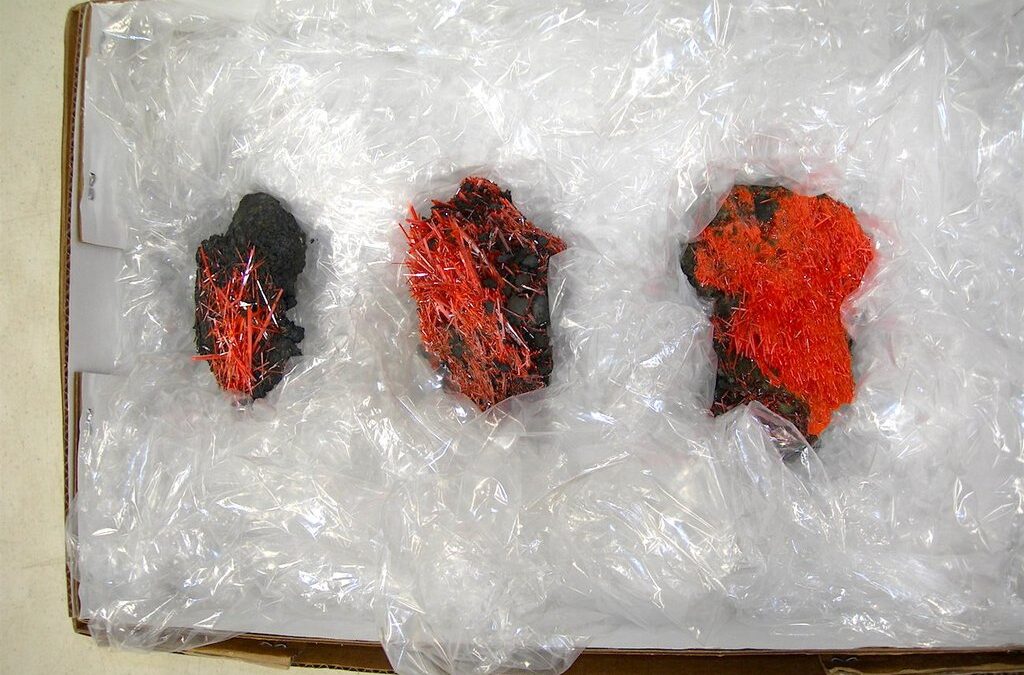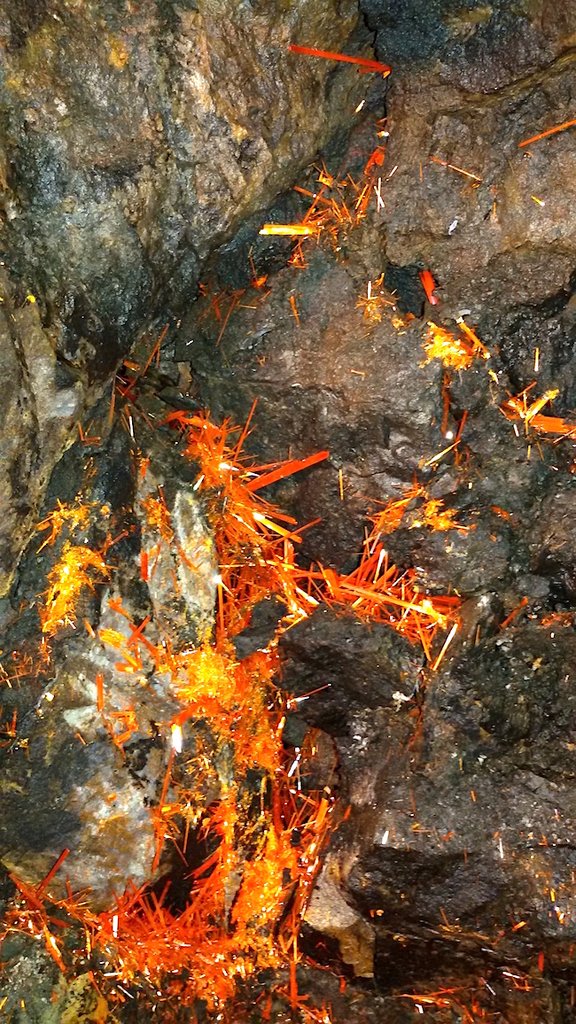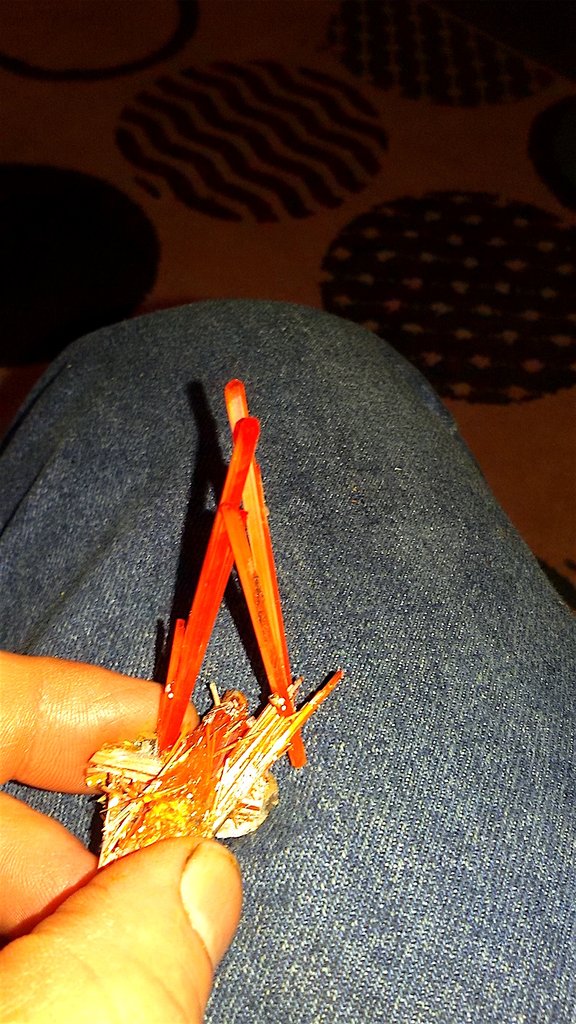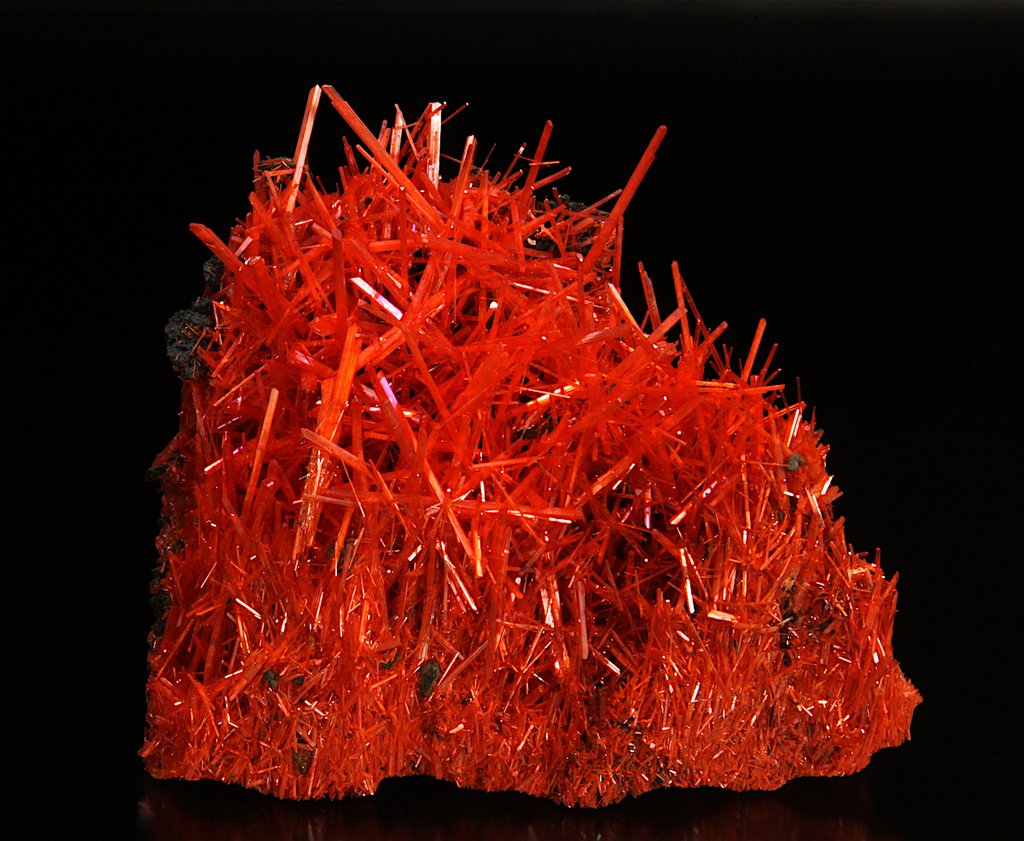Introduction
Collector’s Edge Minerals, Inc., through a partnership agreement with the owner, reopened the Red Lead mine in the Dundas Region, Tasmania, Australia in October 2012, to mine high quality crocoite specimens.
Crocoite, a lead chromate, is found in needle-like, bright red crystals that have long been sought by collectors since their discovery in Russia in 1763. The Red Lead mine has a long history, having been discovered in 1890. In December 2000, crocoite was named the State mineral of Tasmania.
Location
Tasmania is an island state off the Commonwealth of Australia. It is located 240 km off the south-east coast of Australia. The Red Lead mine is located in the Dundas Region of Tasmania approximately 10 km northeast of the town of Zeehan. Zeehan is a small town with less than a thousand people on the west coast of Tasmania, Australia, about 5 kilometers west of the former town of Dundas, for which the Dundas Region is named. The mine is reached by a dirt road that also services the Adelaide mine about 1 km north of the Red Lead mine.
![]()
Map of Tasmania showing Zeehan near the north-western coast. Map by J.W. Pearson & Co., from Pearson’s Australasian School Atlas, 1890-1899. This map can be viewed at https://nla.gov.au/nla.obj-232741223/view
History
Crocoite was originally discovered in the Ural Mountains, near Beresov, Russia in 1763. Though crocoite has since been found at several other locations, Tasmania has produced some of the largest and finest specimens to date. It was first discovered at the Heazlewood silver-lead mine in 1895 and soon after at Whyte River, Magnet and at Dundas.
Zeehan was established to support the mining industry when silver-lead deposits were found in 1882. Mining reached its peak during World War I and lead mining continued in the area to 1963. During its heyday, the Dundas field produced large quantities of crocoite and still does today.
The Red Lead mine, on the southern edge of the Dundas Mining District, was begun as an underground silver-lead mine, discovered by Thomas Page, of Zeehan, in 1890. It was initially named the Dundas Extended mine. Sporadic work was done in the mine until approximately 1894. It was during this time that crocoite was first identified and recorded within the Dundas Mining District. The deposit was reached through a vertical 25 meter shaft and a 92 meter horizontal adit. Unfortunately the ore was oxidized and the mine was abandoned. However, the superb, bright red crocoite specimens being retrieved during this early mining operation far surpassed crocoite being found in the Ural Mountains in Russia. As a result, they were immediately sought after by collectors all over the world.
Mining began again in 1902 for about two years, recovering ferro-manganese. Though typically used as a flux in the processing and manufacture of iron and steel, this ore was processed in the Zeehan smelters for its silver. Ore mined during this period must have encountered an untold quantity of crocoite. In this period of the operation another adit was dug from the base of the 25 meter shaft to intersect a wider section of the ore body. It was during this time that the mine became known as the “Red Lead” mine. The mine lay primarily idle until the mid-1970s, when some surface work was done over the following 30 years mining for crocoite specimens.
In 1986 Shane Dohnt became the owner of the Red Lead mine. His work initially focused on the open-cut surface workings, but shifted underground in the old tunnels in search of crocoite specimens.
In October 2012, Collector’s Edge Minerals, Inc. partnered with Shane to mine for crocoite specimens.
The geology of Western Tasmania is very complex. The region is underlain by rocks dating from Mid-Proterozoic to Cenozoic age, a period when this part of Australia was very active geologically. The rocks in the Dundas area have been subjected to metamorphism, orogenic movements, intrusions, faulting, and mineralization. Pb-Zn-Ag vein deposits at Dundas are associated with a Devonian intrusive event that emplaced granites into the host Cambrian serpentinites and sedimentary rocks, and to a lesser degree into Precambrian slates. These veins are the primary ores for the metals in the Red Lead mine. The host rocks that have formed during oxidation are very porous with numerous open spaces. These are ideal places for the growth of crocoite and other secondary minerals. (Dohnt S., Praszkier, T., 2013)
In the Red Lead mine area the primary ore and the products of its alteration (gossans) occur as veins and pods in carbonate-rich fault zones between Cambrian serpentinites and sedimentary rocks. Alteration in that area is very deep and reaches about 150 m below the surface. Crocoite crystals and associated minerals occur in the vugs and joints in gossans. According to historical reports the size of these bright red crystals reached 15 cm. Some of the crystals are highly lustrous, completely transparent, and very well-terminated. In contrast with the nearby Adelaide mine, hollow “jackstraw“ habit crystals are almost unknown at the Red Lead mine. Recently, several other secondary minerals have been reported from the mine including anglesite and twins of light green cerussite. (Dohnt S., Praszkier, T., 2013)
Crocoite crystals from the Red Lead mine are probably the best in the world in terms of quality and gemminess. Unfortunately this mine has never produced an abundance of specimens like those found in the famous, huge, specimen rich pockets at the Adelaide mine. But hopefully with the new operation many great specimens will be found and offered to the collectors market in the next few years. (Dohnt S., Praszkier, T., 2013)
Crocoite crystals from the Red Lead mine are probably the best in the world in terms of quality and gemminess. Unfortunately this mine has never produced an abundance of specimens like those found in the famous, huge, specimen rich pockets at the Adelaide mine. But hopefully with the new operation many great specimens will be found and offered to the collectors market in the next few years. (Dohnt S., Praszkier, T., 2013)
“Geologic cross-section through the veins of the Dundas ore field (after Bottrill and Baker, 2008). Chromium migrates into the weathering lead-rich sulfide lenses while aluminum and phosphorus migrate in from the sedimentary rocks. Weathering of the gossan zone allows these elements to combine to form secondary minerals including crocoite.”
“Geology of the Dundas area, showing the alignment of the major mines along breccia zones that are near chromium-rich serpentine bodies (after Bottrill and Baker, 2008).”
The Red Lead mine penetrates the highly weathered, dolomite-altered Cambrian ultramafic rock within the same zone as the nearby Adelaide mine. The crocoite is located in pockets within altered gossans of ferromanganese oxides in the surrounding sedimentary host rock. Unlike the Adelaide mine, where the crocoite crystals are often hollow, the Red Lead mine produces solid, well-terminated crystals, some often up to 10-15 cm long. More recently there has been evidence of crystals to 30 cm in length, which, unfortunately, were fractured and not recoverable. However, unlike the Adelaide mine, which produced large quantities of crocoite specimens, the Red Lead mine has not historically been as prolific.
The mine was re-opened in 2012, the old adit was cleaned out, re-timbered, and exploratory work began drifting and examining veins that are about 18-21 m beneath the existing open pit floor. Extensive mapping of the mine was also performed to evaluate the geology and existing workings. Because of the limited size of the tunnels, typically 1.5 m wide and 2.4 m tall, small powered mining equipment was purchased to access the confined space.
General plan of the workings in the Red Lead mine as of 2013. The main tunnel is about 200 m in length. Cross-cuts are located in the fault zones with rich crocoite mineralization (red color). Location of the “Stop the Bleeding Pocket” is marked (green circle).
One of the three new mechanized machines purchased for this effort is called a “Dingo”. As seen in the photo below, it has a spiral auger with a cutter attachment at the end. The auger can drill a 30 cm diameter hole to a depth of about 1 meter. Once several holes are drilled, the auger is removed and a jackhammer is attached to the “Dingo” to remove the rock between the holes. Along with the other two machines, which are used to remove the resulting ‘muck’, or waste rock, the mining can progress about 2 meters per day.
Auger attachment on the “Dingo”. S. Dohnt photo.
Safety in any mining operation is paramount. Because of the instability of the ceiling and walls in the mine, new and additional shoring, with wire mesh placed in-between, was installed to meet safety requirements required by the new mine safety management plan. Furthermore, effort was made to provide proper ventilation, including using biodiesel fuel to reduce exhaust fumes.
During the first year, after the mine was cleaned out, and new shoring and ventilation installed. At the same time, an inclined raise was created to provide better access to equipment. Effort then focused on crosscut 1. While this area was being shored up, work focused on a promising vein, referred to as ‘Hannah’s Lode’. While drifting along this vein, a pocket was encountered, referred to as the “Stop The Bleeding Pocket”. Though only 60 cm wide by 10 cm high by 30 cm deep, the crocoites were quite nice. Work continued on this stope that, according to surveys, showed that the lode extends vertically for 100 meters and 400 meters on the surface.
Success was limited but effort continues in the back of the mine where a good zone has been found. To date it has been yielding larger, bright red crystals with good terminations.
In case people think mining is glamorous, the following pictures illustrate the conditions under which this mining work was conducted. In western Tasmania, it rains a lot and the wet, humid conditions require working constantly in a muddy environment in a somewhat hazardous environment. Protective clothing makes the work hot and sweaty and hand-held lighting makes it difficult to see well. As mentioned earlier, the gossans are unstable and require shoring up the walls and ceiling to prevent their collapse during mining.
This was the condition of the underground workings after the adit was reopened and drained. S. Dohnt photo.
View of mine entrance. The mine is constantly wet, making working conditions challenging.
Mucking out the mine with this buggy. Notice the treads on the vehicle for better traction.
View of new timbering in the mine – note the wire mesh to prevent the adit walls from caving in.
This is a view of the main tunnel after cleaning out the old shoring, installing new timbers and a ventilation system. S. Dohnt photo.
View of in-situ crocoite pocket.
Shane Dohnt, the current mine owner, and George Quist (CEMI) using a diamond chain saw to extract crocoite specimens.
Graham Sutton (CEMI) examining a crocoite pocket.
In-situ pockets of crocoite crystals. Larger crystals measure 3 to 4 cm long.
The best crocoite at the Red Lead mine has been found in open cavities ranging from a few centimeters long to almost one meter in length and a few centimeters wide. These cavities are found along the main load bisecting the lease. Crystals are rarely found unattached as “floaters”. More commonly, the pockets are found on NW lying parallel fractures that are completely filled and prevent recovery of any decent specimens.
In some areas where clay fills the pockets, protecting the crystals, small pneumatic jackhammers are used to remove matrix material potentially containing intact crystals. Otherwise the diamond chainsaw is used to cut out larger matrix pieces from the surrounding rock. The collected specimens are then staged in the mine tunnel and packed before being moved to the surface for initial cleaning and grading. High value pieces are then packed for shipment to the Collector’s Edge laboratory in Golden, Colorado for final cleaning, trimming, and sale.
The following photos were taken of packages received at the Collector’s Edge laboratory in Golden. Note how they are specially packaged, the box is first lined with foam rubber, then the specimen is placed inside the box and encased in investment (a plaster-like material used in the ‘lost wax’ process when casting jewelry). Smaller specimens are packed in plastic wrap to minimize damage during transport. Generally transport is by air freight, though they are sometimes sent by cargo ship.
The crocoite specimen as received at the Collector’s Edge laboratory. Specimen was approximately 38 cm long before trimming.
The same specimen shown in the previous photo, after final trimming and ready for sale. Final specimen is 7.5 cm x 20 cm x 9 cm.
Note that even though the specimen is firmly packed in foam and “investment”, some crocoite crystals still loosen during shipment.
Crocoite specimen as received at the Collector’s Edge laboratory. After releasing specimen from its protective “wrapping”, it required very little trimming, as shown below!
The same large specimen, shown in the previous photo, 25 cm x 26 cm x 7 cm, now in the Smithsonian Institution collection.
Specimens above are “as received” from the mine workings, and each measures approximately 12 cm x 7 cm.
Crocoite: PbCrO4
Once received at the Collector’s Edge laboratory in Golden, Colorado, the specimens are removed from their packaging, and decisions are made how to best proceed with cleaning and trimming. The following photos were taken of specimens after being processed.
Named “The Beacon”, this specimen is approximately 17 cm high x 18 cm wide. When placed in a case with other specimens, this piece shines like a bright light!
Bright red-orange crocoite crystals filling a 10 cm long vug. S. Dohnt photo.
“Fan-like” cluster of doubly terminated crocoite crystals, 4.5 cm high.
Gemmy crocoite crystal, note phantoms, 1.5 cm high.
Crocoite specimen, 11 cm wide.
Fabulous crocoite in cavity, 7 cm high.
Other Minerals
Anglesite: PbSO4
Anglesite has been found associated with galena in small cavities. Crystals up to 5 mm have been identified.
Cerussite: PbCO3
Cerrusite is a lead carbonate that has been found associated with crocoite. The Dundas area is known for its yellow “chrome cerrusite”. At the Red Lead mine, light green crystals to 2.5 cm have been found in association with the crocoite.
Chalcophanite: (Zn,Fe,Mn)Mn3O7.3H2O
Tabular purple-black crystals to 2 mm have been found in cavities as well as crystalline masses several centimeters across.
Galena: PbS
Remnant masses of coarsely crystalline galena have been found rarely in lode structures.
Other minerals that have been identified include: goethite, grimaldite, petterdite, philipsbornite, and reynoldsite.
Current Status
Collector’s Edge Minerals, Inc. continues working with the mine owner to mine and ship high quality crocoite specimens to its laboratory in Golden, Colorado for cleaning, preparation and marketing.
References
Dohnt, S., and Praszkier, T. (2013) Red Lead Mine, Tasmania: a new chapter of mining, Spirifer Minerals Issue #7 The Collector’s Newspaper 2013, pp 1, 13-15.
Bottrill & Baker (2008) “A Catalog Of The Minerals Of Tasmania”, Geological Survey Bulletin 73, Mineral Resources Tasmania.
Bottrill, R. S., Williams, P., Dohnt, S., Sorrell, S., and Kemp, N. R. (2006) Crocoite and associated minerals from Dundas and other locations in Tasmania. Australian Journal of Mineralogy, 12 (6), 59–90.






